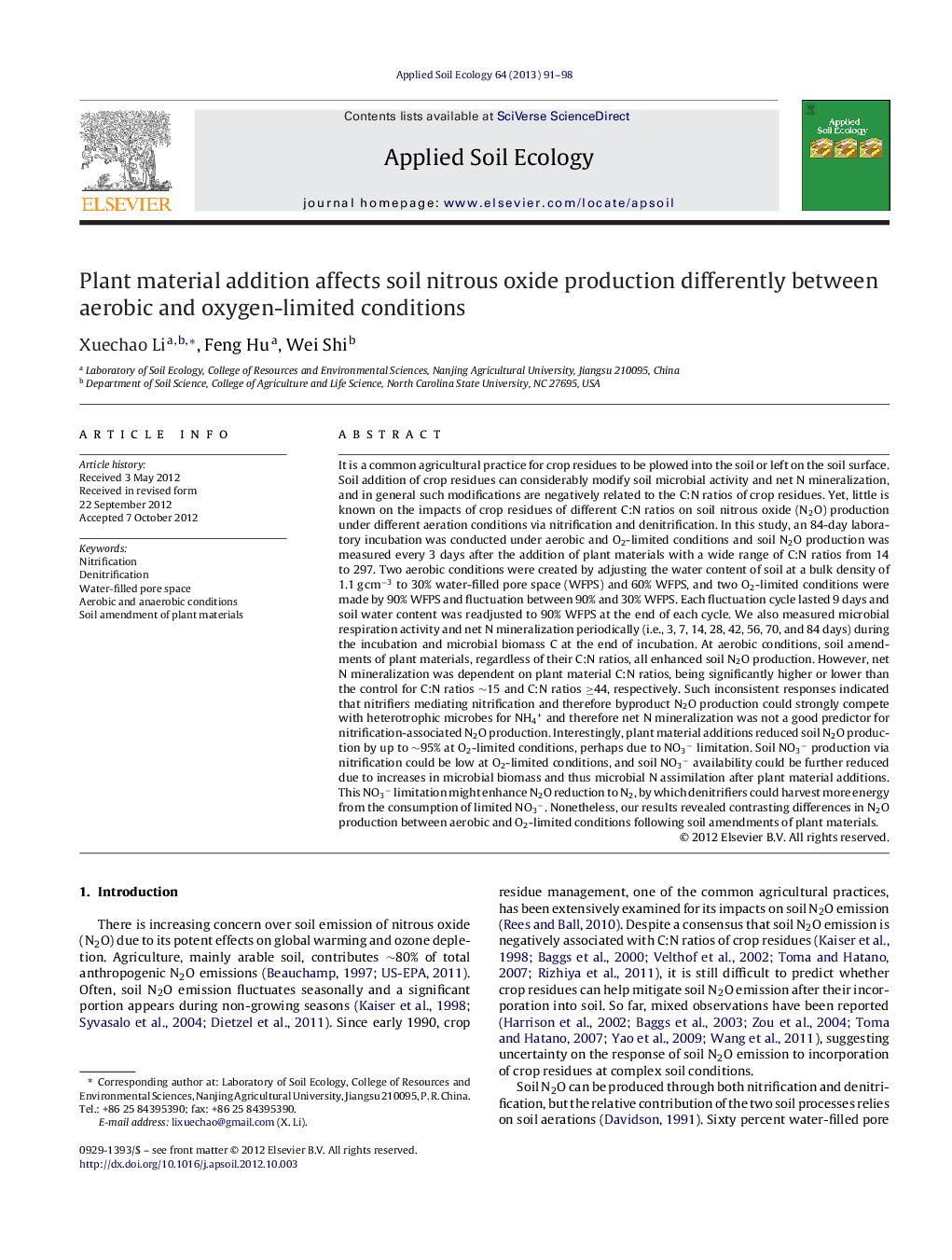| کد مقاله | کد نشریه | سال انتشار | مقاله انگلیسی | نسخه تمام متن |
|---|---|---|---|---|
| 4382461 | 1617819 | 2013 | 8 صفحه PDF | دانلود رایگان |

It is a common agricultural practice for crop residues to be plowed into the soil or left on the soil surface. Soil addition of crop residues can considerably modify soil microbial activity and net N mineralization, and in general such modifications are negatively related to the C:N ratios of crop residues. Yet, little is known on the impacts of crop residues of different C:N ratios on soil nitrous oxide (N2O) production under different aeration conditions via nitrification and denitrification. In this study, an 84-day laboratory incubation was conducted under aerobic and O2-limited conditions and soil N2O production was measured every 3 days after the addition of plant materials with a wide range of C:N ratios from 14 to 297. Two aerobic conditions were created by adjusting the water content of soil at a bulk density of 1.1 g cm−3 to 30% water-filled pore space (WFPS) and 60% WFPS, and two O2-limited conditions were made by 90% WFPS and fluctuation between 90% and 30% WFPS. Each fluctuation cycle lasted 9 days and soil water content was readjusted to 90% WFPS at the end of each cycle. We also measured microbial respiration activity and net N mineralization periodically (i.e., 3, 7, 14, 28, 42, 56, 70, and 84 days) during the incubation and microbial biomass C at the end of incubation. At aerobic conditions, soil amendments of plant materials, regardless of their C:N ratios, all enhanced soil N2O production. However, net N mineralization was dependent on plant material C:N ratios, being significantly higher or lower than the control for C:N ratios ∼15 and C:N ratios ≥44, respectively. Such inconsistent responses indicated that nitrifiers mediating nitrification and therefore byproduct N2O production could strongly compete with heterotrophic microbes for NH4+ and therefore net N mineralization was not a good predictor for nitrification-associated N2O production. Interestingly, plant material additions reduced soil N2O production by up to ∼95% at O2-limited conditions, perhaps due to NO3− limitation. Soil NO3− production via nitrification could be low at O2-limited conditions, and soil NO3− availability could be further reduced due to increases in microbial biomass and thus microbial N assimilation after plant material additions. This NO3− limitation might enhance N2O reduction to N2, by which denitrifiers could harvest more energy from the consumption of limited NO3−. Nonetheless, our results revealed contrasting differences in N2O production between aerobic and O2-limited conditions following soil amendments of plant materials.
► Plant material affected N2O production differently at contrasting soil aerations.
► At 30% and 60% WPFS, plant material addition increased soil N2O production.
► At 90% WFPS, plant material addition decreased soil N2O production.
► Fluctuation between 90% and 30% WFPS also reduced N2O production from amended soil.
► Soil N2O production was highest at fluctuation, followed by 90%, 60% and 30% WFPS.
Journal: Applied Soil Ecology - Volume 64, February 2013, Pages 91–98